Intra-Minute Cloud Passing Forecasting Based on a Low Cost IoT Sensor—A Solution for Smoothing the Output Power of PV Power Plants
Abstract
:1. Introduction
2. Cloud Passing Forecasting System
- It must be able to take photos of the sky independently without sunshades;
- It must also be able to recognize clouds near the Sun, when the Sun is located perpendicularly to a camera;
- No moving parts;
- All hardware and optics must be low-cost;
- The cloud passing forecasting algorithm must be applicable on low-cost IoT modules.
2.1. Image Acquisition Hardware
2.2. Sun Recognition
2.3. Recognition of Clouds
2.4. Prediction of Cloud Movement in the Vicinity of the Sun
- (a)
- The checkpoints around the Sun are defined;
- (b)
- The cloud covered checkpoint closest to the Sun is identified;
- (c)
- A square area around the cloud covered checkpoint from step (b) is defined;
- (d)
- For the pixels identified as a cloud inside this area, the center of gravity is calculated;
- (e)
- The same procedure as described in step (d) is repeated for the newly taken photo;
- (f)
- The change in the position of the center of gravity between steps (d) and (e) is used to define the cloud’s motion, considering the time between both of the taken photos;
- (g)
- It is checked if the cloud moves towards the Sun’s center and when the Sun’s center will be covered by the cloud;
- (h)
- If the time when the Sun’s center will be covered by the cloud exceeds the preset value, the trigger signal for the reduction of the PV system output power is generated.
3. Results
4. Conclusions
- Detecting clouds in the vicinity of the Sun;
- Determining the cloud’s movement;
- Determining the distance between the cloud and the Sun;
- Predicting the time during which the cloud will cover the Sun.
Author Contributions
Conflicts of Interest
Appendix A

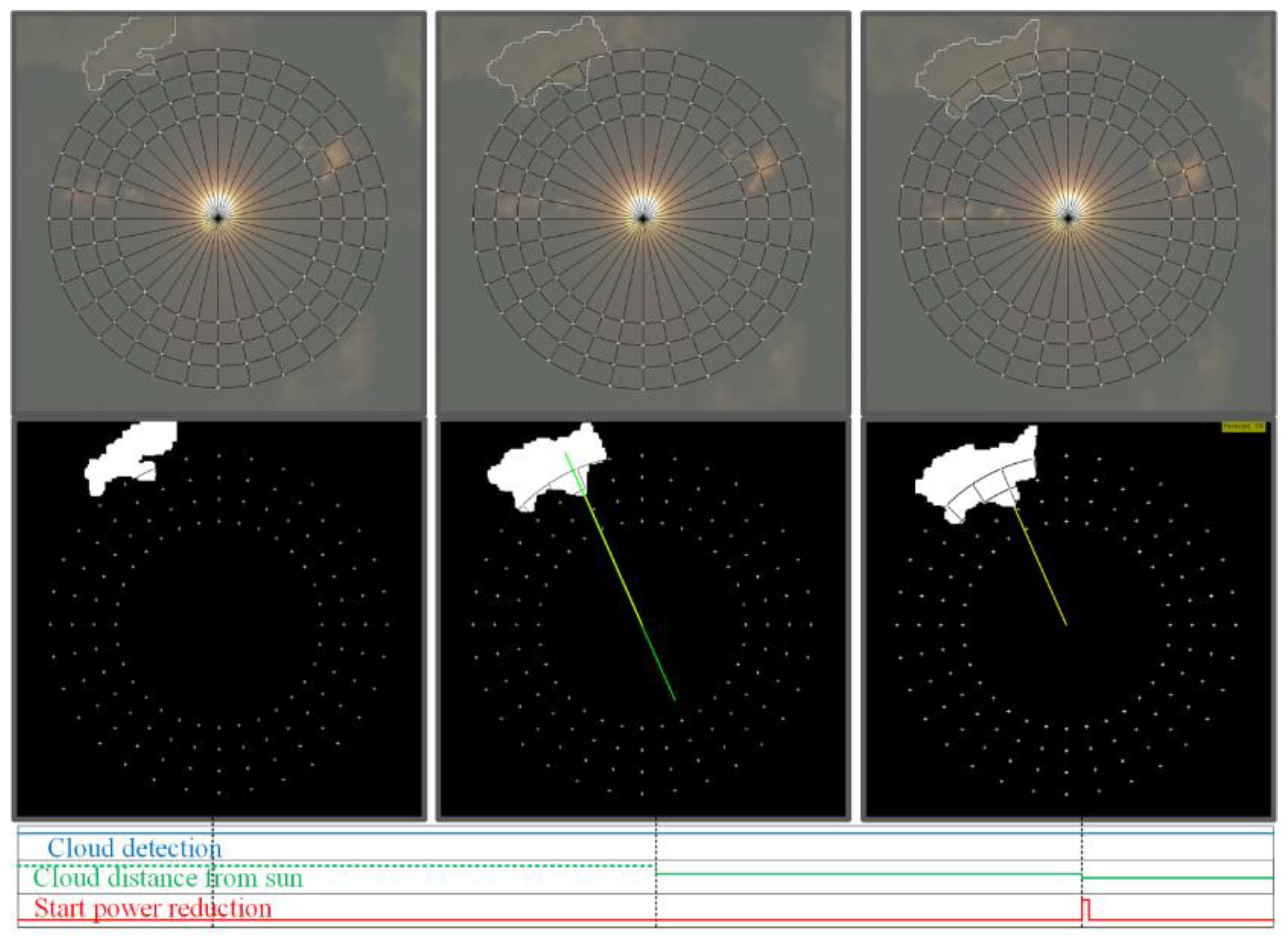
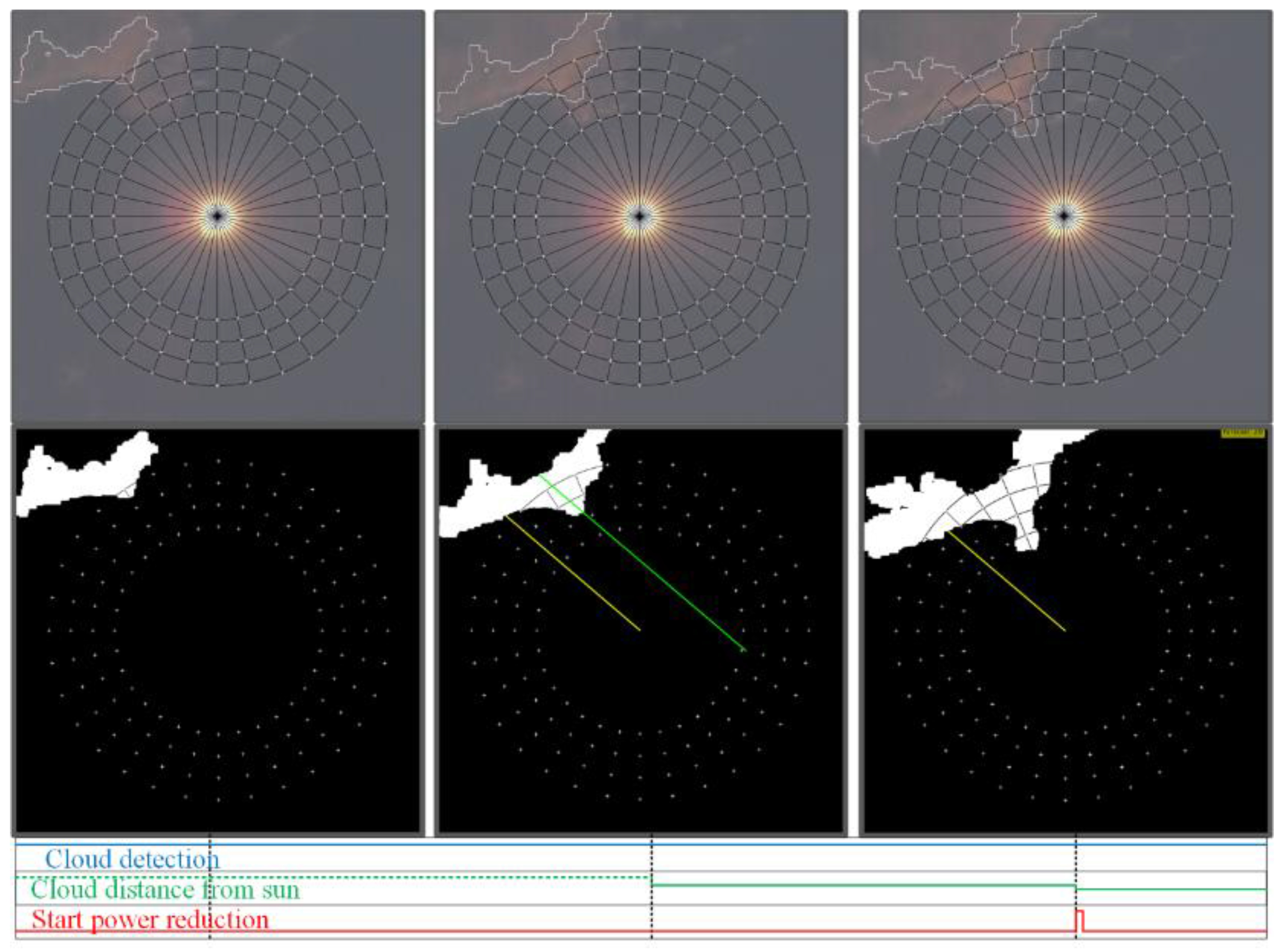

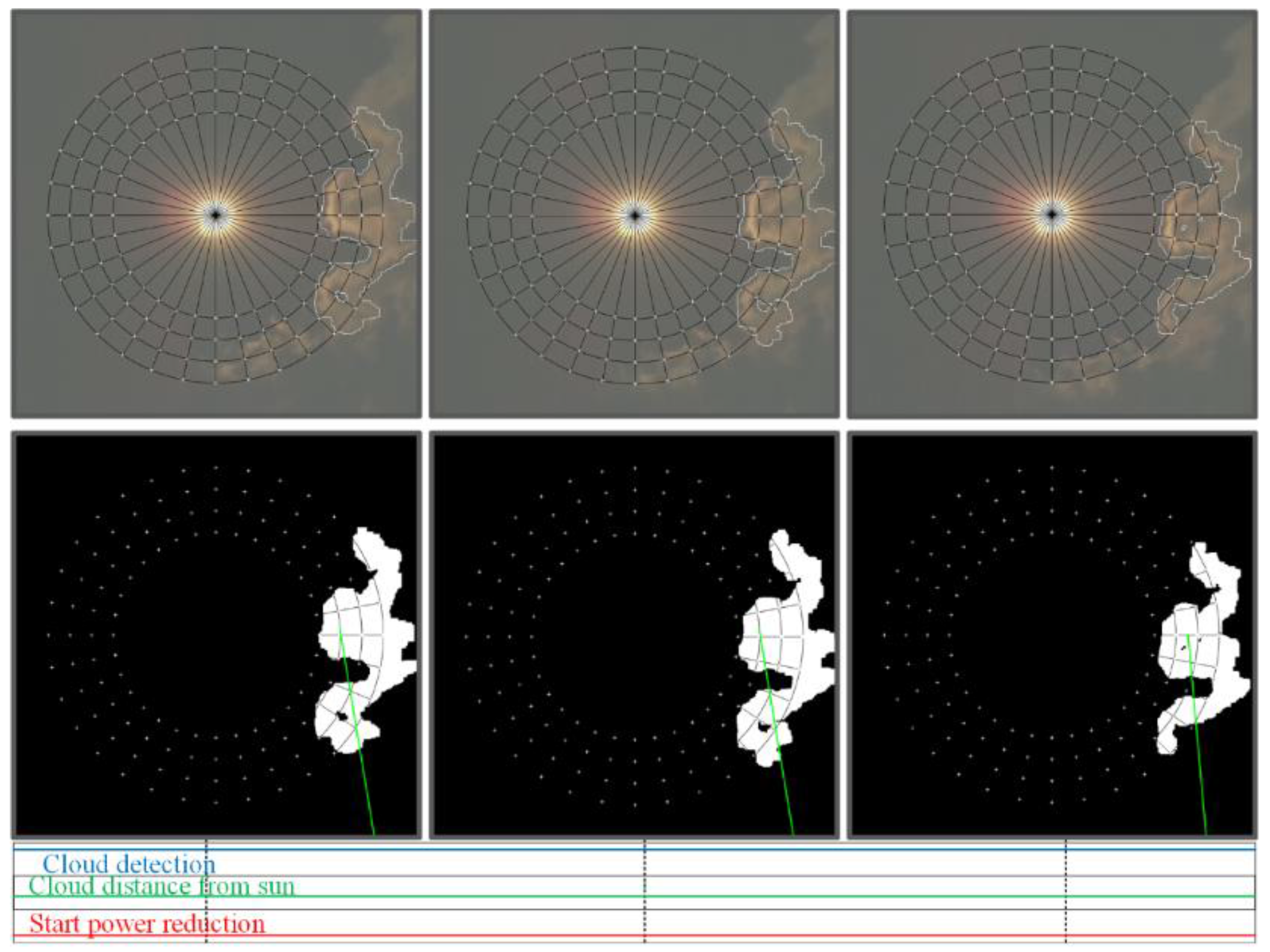



References
- Thomas, E.H.; Richard, P. Quantifying PV power Output Variability. Sol. Energy 2010, 10, 1782–1793. [Google Scholar]
- Sayeef, S.; Heslop, S.; Cornforth, D.; Moore, T.; Percy, S.; Ward, J.; Berry, A. Solar Intermittency: Australia’s Clean Energy Challenge: Characterising the Effect of High Penetration Solar Intermittency onAustralian Electricity Networks; CSIRO: Newcastle, UK, 2012. [Google Scholar]
- Shivashankar, S.; Mekhilef, S.; Mokhlis, H.; Karimi, M. Mitigating methods of power fluctuation of photovoltaic (PV) sources—A review. Renew. Sustain. Energy Rev. 2016, 59, 1170–1184. [Google Scholar] [CrossRef]
- Cheng, F.; Willard, S.; Hawkins, j.; Arellano, B.; Mammoli, A. Applying battery energy storage to enhance the benefits of photovoltaics. In Proceedings of the 2012 IEEE Energytech, Cleveland, OH, USA, 29–31 May 2012. [Google Scholar]
- Ellis, A.; Schoenwald, D.; Hawkins, J.; Willard, S.; Arellano, B. PV output smoothing with energy storage. In Proceedings of the 38th IEEE Photovoltaic Specialists Conference, Austin, TX, USA, 3–8 June 2012. [Google Scholar]
- Puri, A. Optimally smoothing output of PV farms. In Proceedings of the 2014 IEEE PES General Meeting, Harbor, MD, USA, 27–31 July 2014. [Google Scholar]
- Puri, A. Bounds on the smoothing of renewable sources. In Proceedings of the 2015 IEEE Power & Energy Society General Meeting, Denver, CO, USA, 26–30 July 2015. [Google Scholar]
- Chow, C.W.; Urquhart, B.; Lave, M.; Dominguez, A.; Washom, B. Intra-hour forecasting with a total sky imager at the UC San Diego solar energy testbed. Sol. Energy 2011, 11, 2881–2893. [Google Scholar] [CrossRef]
- Alonso-Montesinos, J.; Batlles, F.; Portillo, C. Solar irradiance forecasting at one-minute intervals for different sky conditions using sky camera images. Energy Convers. Manag. 2015, 105, 1166–1177. [Google Scholar] [CrossRef]
- Alonso-Montesinos, J.; Batlles, F. The use of a sky camera for solar radiation estimation based on digital image processing. Energy 2015, 90, 377–386. [Google Scholar] [CrossRef]
- Marquez, R.; Coimbra, C. Intra-hour DNI forecasting based on cloud tracking image analysis. Sol. Energy 2012, 91, 327–336. [Google Scholar] [CrossRef]
- Johnson, R.W.; Hering, W.; Shields, J. Automated Visibility and Cloud Cover Measurements with a Solid State Imaging System; University of California: San Diego, CA, USA, 1989. [Google Scholar]
- Hammer, A.; Heinemann, D.; Lorenz, E.; Lückehe, B. Short-term forecasting of solar radiation: A statistical approach using satellite data. Sol. Energy 1999, 67, 139–150. [Google Scholar] [CrossRef]
- Jang, H.S.; Bae, K.Y.; Park, H.-K.; Sung, D.K. Solar Power Prediction Based on Satellite Images and Support Vector Machine. IEEE Trans. Sustain. Energy 2016, 7, 1255–1263. [Google Scholar] [CrossRef]
- Romain, D.; Philippe, B.; Jocelyn, C.; Didier, B. Very short term forecasting of the Global Horizontal Irradiance using a spatio-temporal autoregressive model. Renew. Energy 2014, 72, 291–300. [Google Scholar]
- Vincent P.A., L.; Vijai, T.J.; Alexander, D.C. Forecasts of PV power output using power measurements of 80 residential PV installs. In Proceedings of the 2012 IEEE Photovoltaic Specialists Conference, Austin, TX, USA, 3–8 June 2012. [Google Scholar]
- Lonij, V.P.; Brooks, A.E.; Cronin, A.D.; Leuthold, M.; Koch, K. Intra-hour forecasts of solar power production using measurements from a network of irradiance sensors. Sol. Energy 2013, 97, 58–66. [Google Scholar] [CrossRef]
- Andrea, M.; John, S. Low-cost solar micro-forecasts for PV smoothing. In Proceedings of the 2013 IEEE Conference on Technologies for Sustainability, Portland, OR, USA, 1–2 August 2013. [Google Scholar]
- Bao, G.; Xu, F. An ultra-short-term power prediction model based on machine vision for distributed photovoltaic system. In Proceedings of the 2015 IEEE International Conference on Information and Automation, Lijiang, China, 8–10 August 2015. [Google Scholar]
- Cai, D.; Xie, T.; Huang, Q.; Li, J. Short-term solar photovoltaic irradiation predicting using a nonlinear prediction method. In Proceedings of the PES General Meeting|Conference & Exposition, National Harbor, MD, USA, 27–31 July 2014. [Google Scholar]
- Long, C.N. Total Sky Imager Model 880 Status and Testing Results; Pacific Northwest National Laboratory: Richland, WA, USA, 2001. [Google Scholar]
- Slater, D.W.; Long, C.N. Total Sky Imager/Whole Sky Imager Cloud Fraction Comparison. In Proceedings of the Eleventh ARM Science Team Meeting Proceedings, Atlanta, GA, USA, 19–23 March 2001. [Google Scholar]
- Yang, H.; Kurtz, B.; Nguyen, D.; Urquhart, B.; Kleissl, J. Solar irradiance forecasting using a ground-based sky imager developed at UC San Diego. Sol. Energy 2014, 103, 502–524. [Google Scholar] [CrossRef]
- Urquhart, B.; Kurtz, B.; Kleissl, J. Development of A Sky Imaging System for Short-Term Solar Power Forecasting. Atmos. Meas. Tech. 2015, 8, 875–890. [Google Scholar] [CrossRef]
- Jessi, S.; Andrew, J.; Andreas, W.; Paul, D. Direct HDR capture of the sun and sky. In Proceedings of the 3rd International Conference on Computer Graphics, Virtual Reality, Visualisation and Interaction in Africa (AFRIGRAPH), Stellenbosch, South Africa, 3–5 November 2004. [Google Scholar]
- Ghonima, M.S.; Urquhart, B.; Chow, C.W.; Shields, J.E.; Cazorla, A.; Kleissl, J. A method for cloud detection and opacity classification based on ground based sky imagery. Atmos. Meas. Tech. 2012, 5, 2881–2892. [Google Scholar] [CrossRef]
- Quesada-Ruiz, S.; Coimbra, C. Cloud-tracking methodology for intra-hour DNI forecasting. Sol. Energy 2014, 102, 267–275. [Google Scholar] [CrossRef]
- Voyant, C.; Notton, G.; Kalogirou, S.; Nivet, M.-L.; Paoli, C.; Motte, F.; Fouilloy, A. Machine learning methods for solar radiation forecasting: A review. Renew. Energy 2017, 105, 569–582. [Google Scholar] [CrossRef]
- Taravat, A.; Fabio, D.F.; Cristina, C.; Stefania, V. Neural Networks and Support Vector Machine Algorithms for Automatic Cloud Classification of Whole-Sky Ground-Based Images. IEEE Geosci. Remote Sens. Lett. 2015, 12, 666–671. [Google Scholar] [CrossRef]
- Chu, Y.; Li, M.; Coimbra, C.F. Sun-tracking imaging system for intra-hour DNI forecasts. Renew. Energy 2016, 96, 792–799. [Google Scholar] [CrossRef]
- Zhou, L.; Hu, R.Q.; Qian, Y.; Chen, H.H. Energy-Spectrum Efficiency Tradeoff for Video Streaming over Mobile Ad Hoc Networks. IEEE J. Sel. Areas Commun. 2013, 31, 981–991. [Google Scholar] [CrossRef]
- Zhou, L.; Wang, H.; Guizani, M. How Mobility Impacts Video Streaming over Multi-Hop Wireless Networks? IEEE Trans. Commun. 2012, 60, 2017–2028. [Google Scholar] [CrossRef]
- Reda, I.; Andreas, A. Solar Position Algorithm for Solar Radiation Applications. Sol. Energy 2003, 76, 577–589. [Google Scholar] [CrossRef]
- Pfister, G.; McKenzie, R.L.; Liley, J.B.; Thomas, W.; Forgan, B.W.; Long, C.N. Cloud coverage based on all-sky imaging and its impact on surface solar irradiance. Am. Meteorol. Soc. 2003, 42, 1421–1434. [Google Scholar] [CrossRef]
- Long, C.N.; DeLuisi, J.J. Development of an automated hemispheric sky imager for cloud fraction retrievals. In Proceedings of the Tenth Symposium on Meteorological Observations and Instrumentation, Phoenix, AZ, USA, 11–16 January 1998. [Google Scholar]
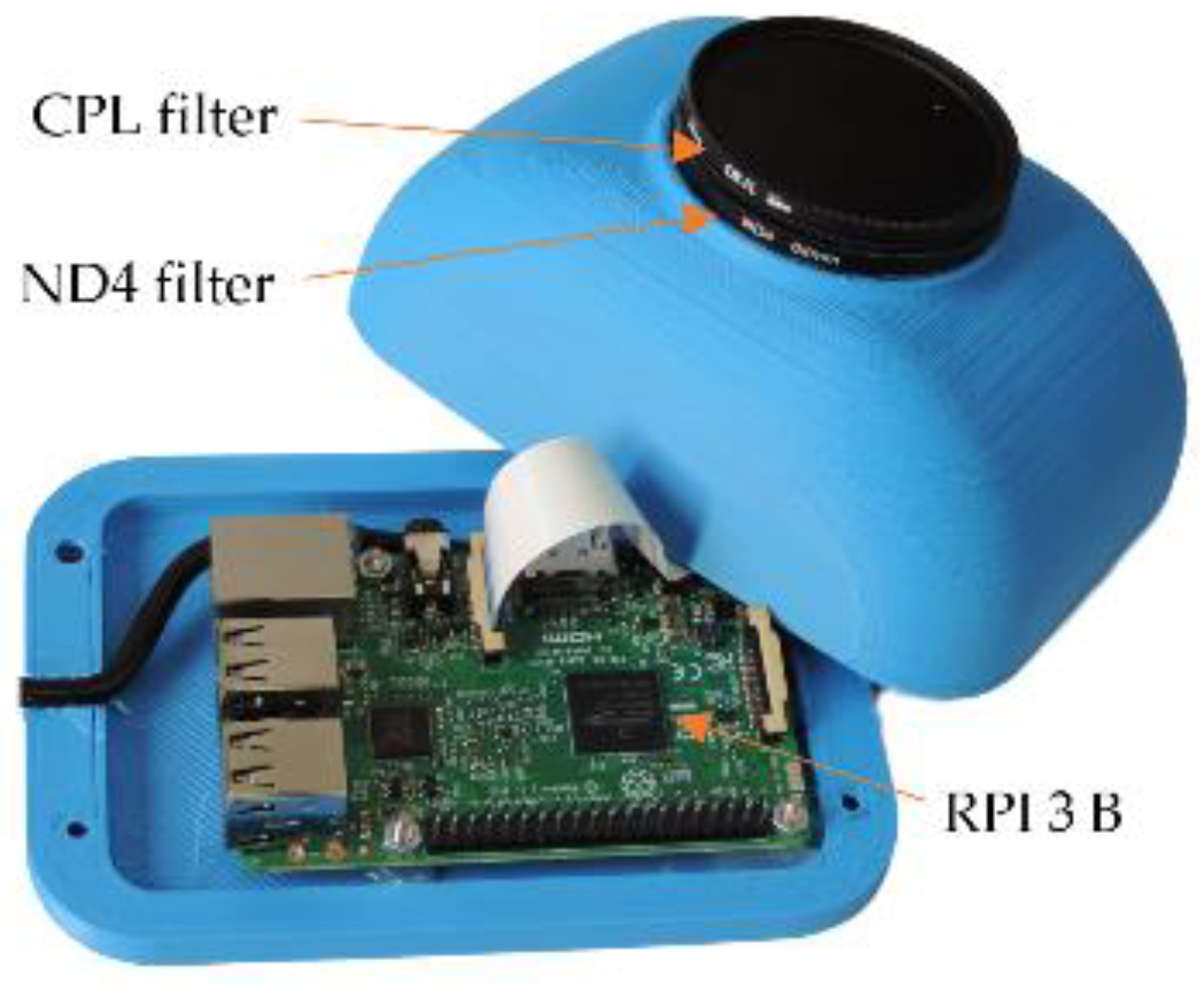
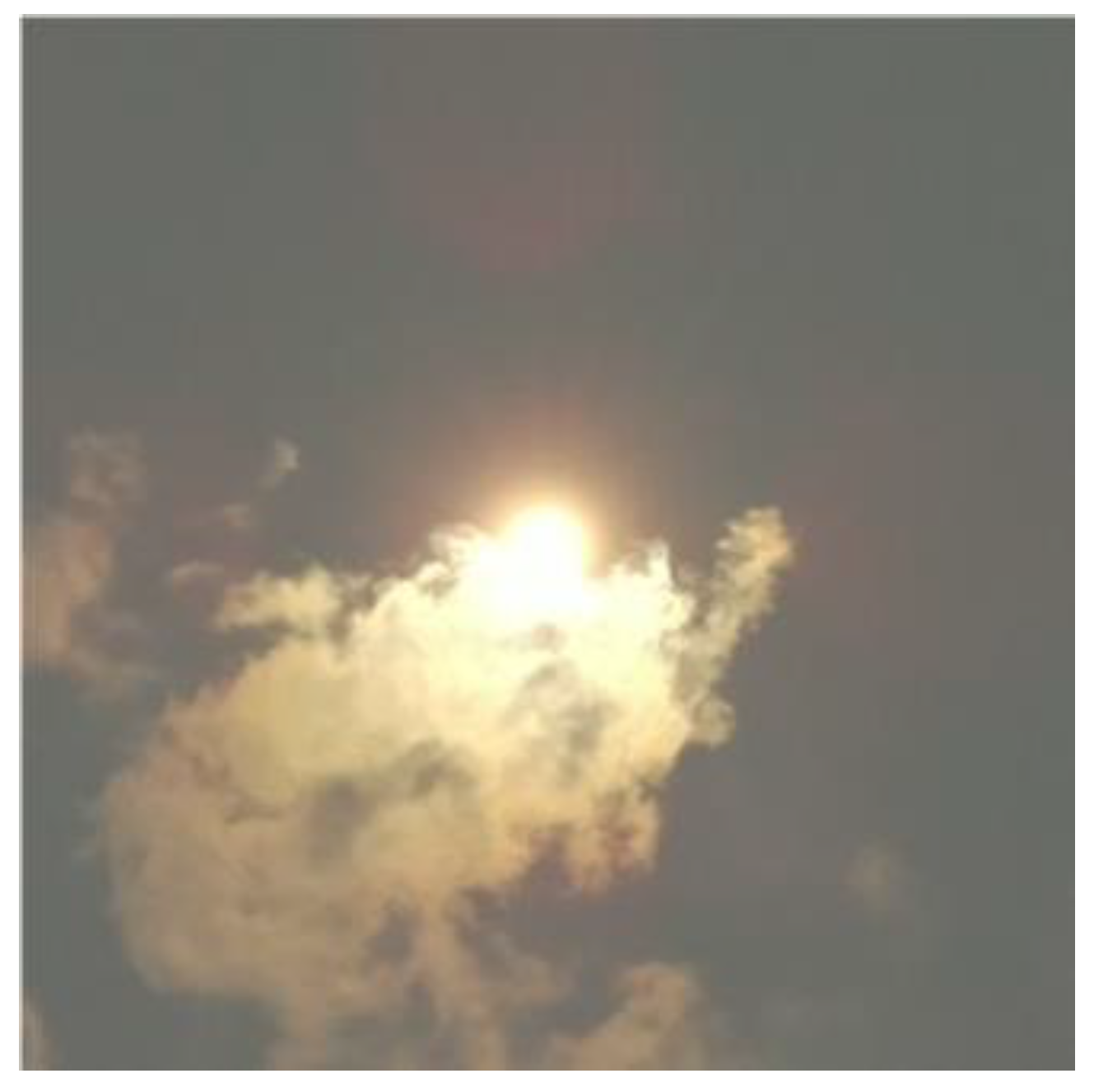


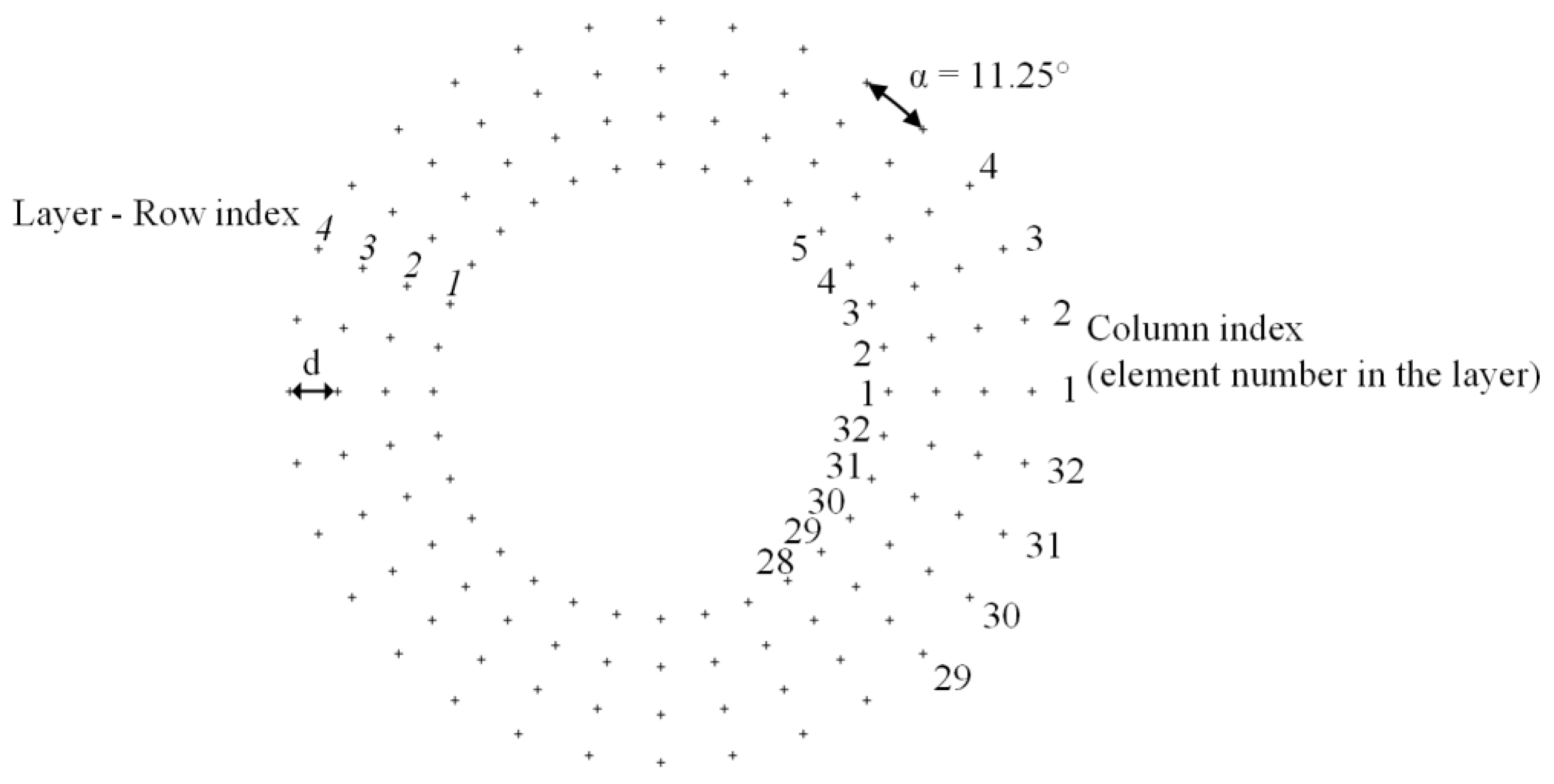
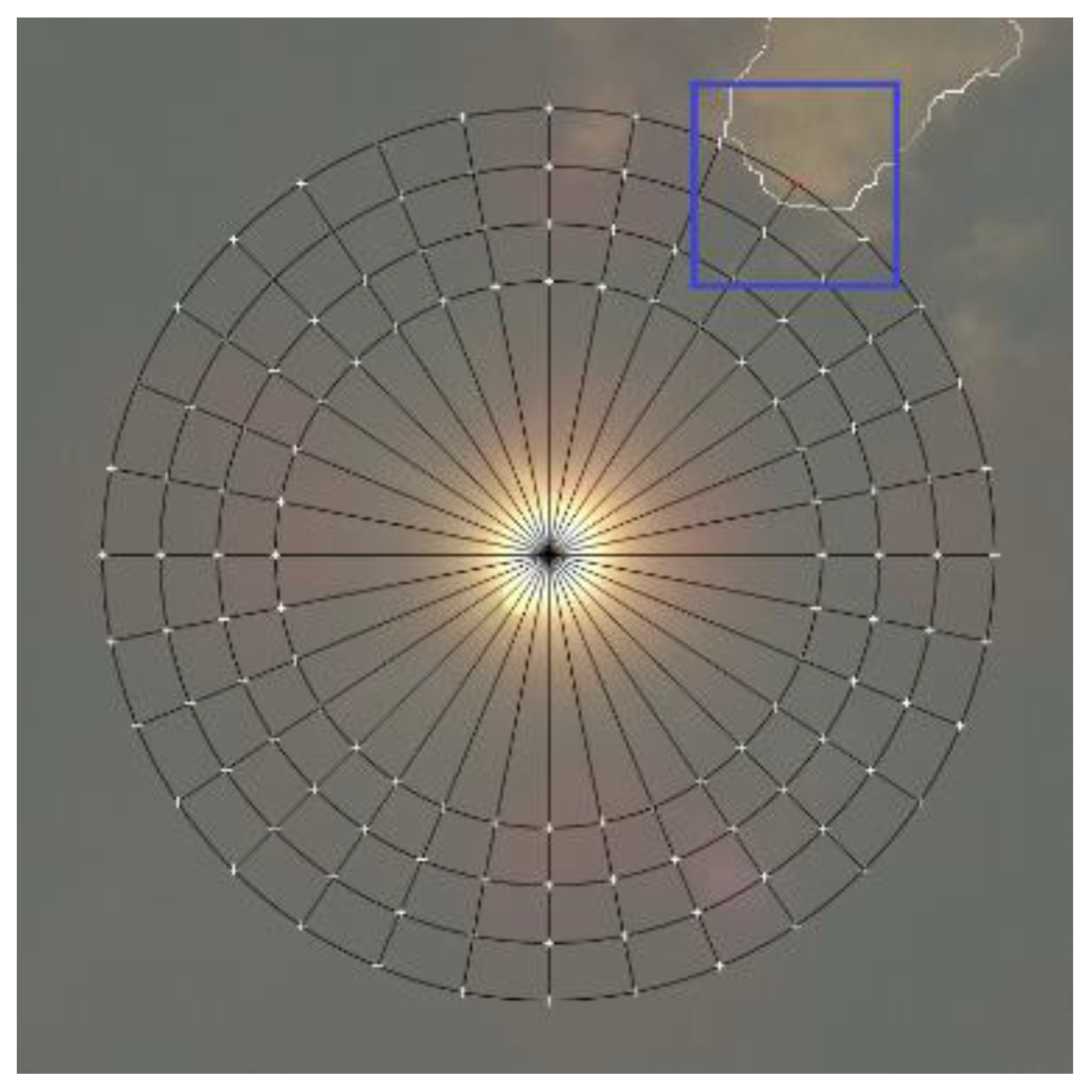


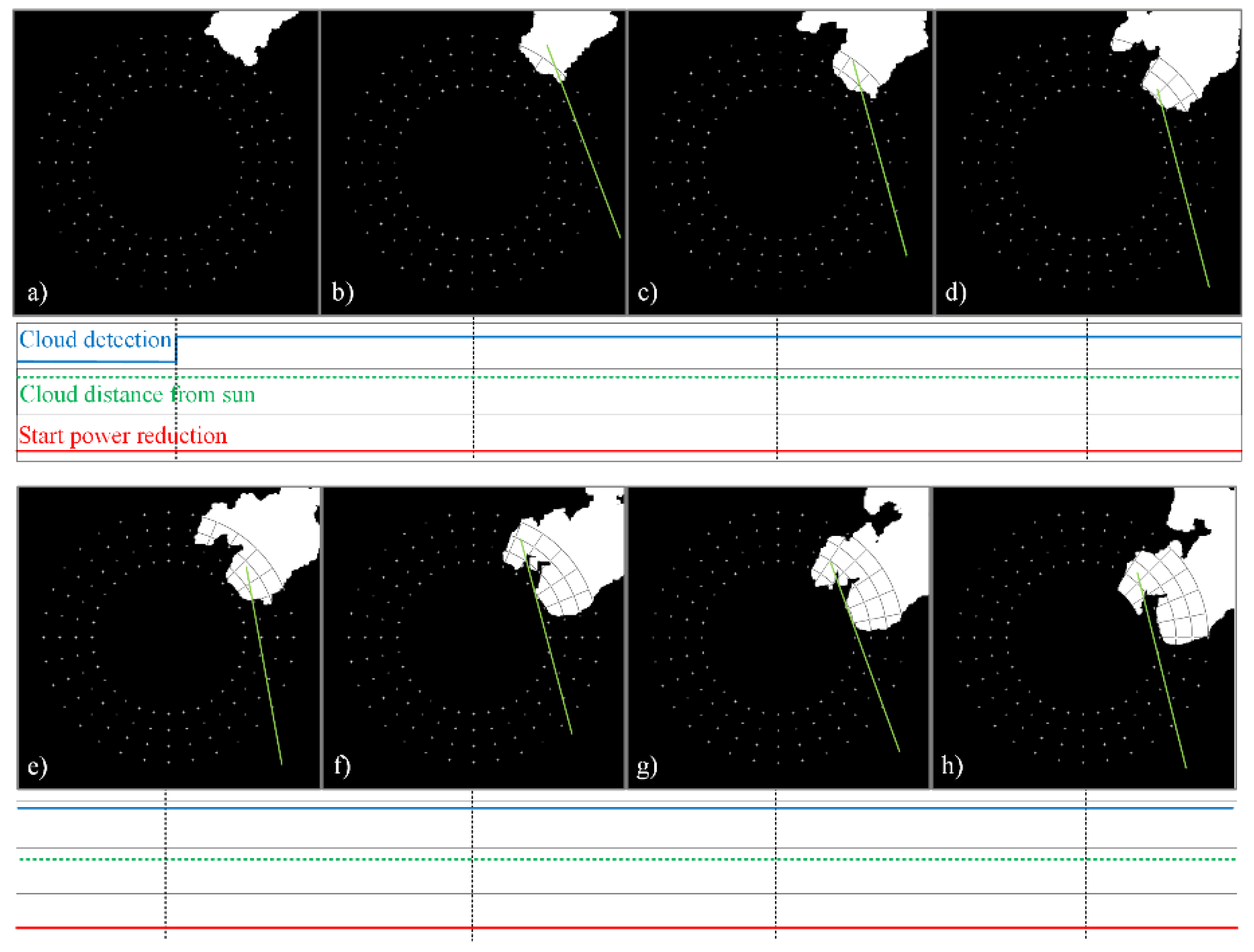
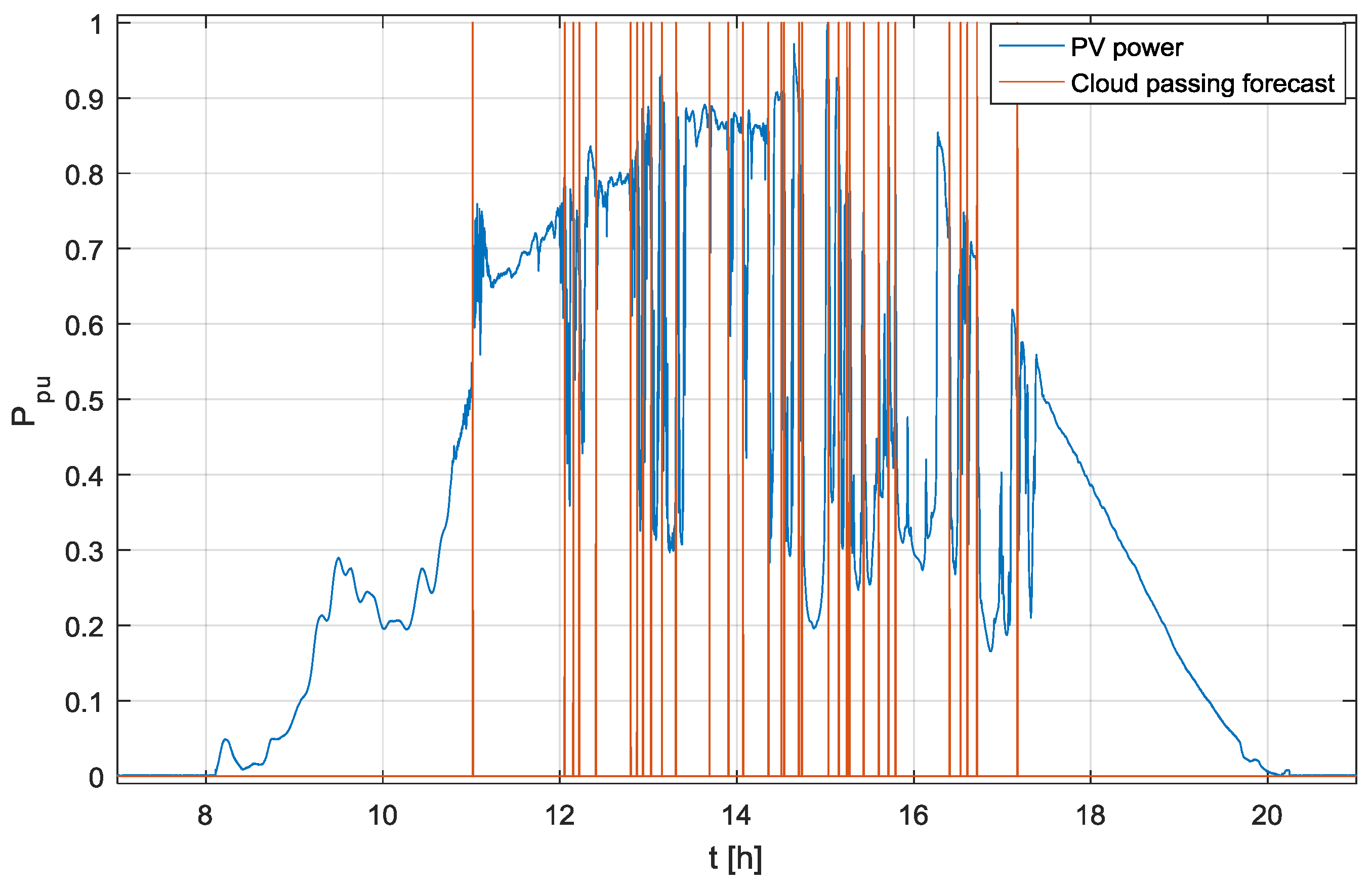
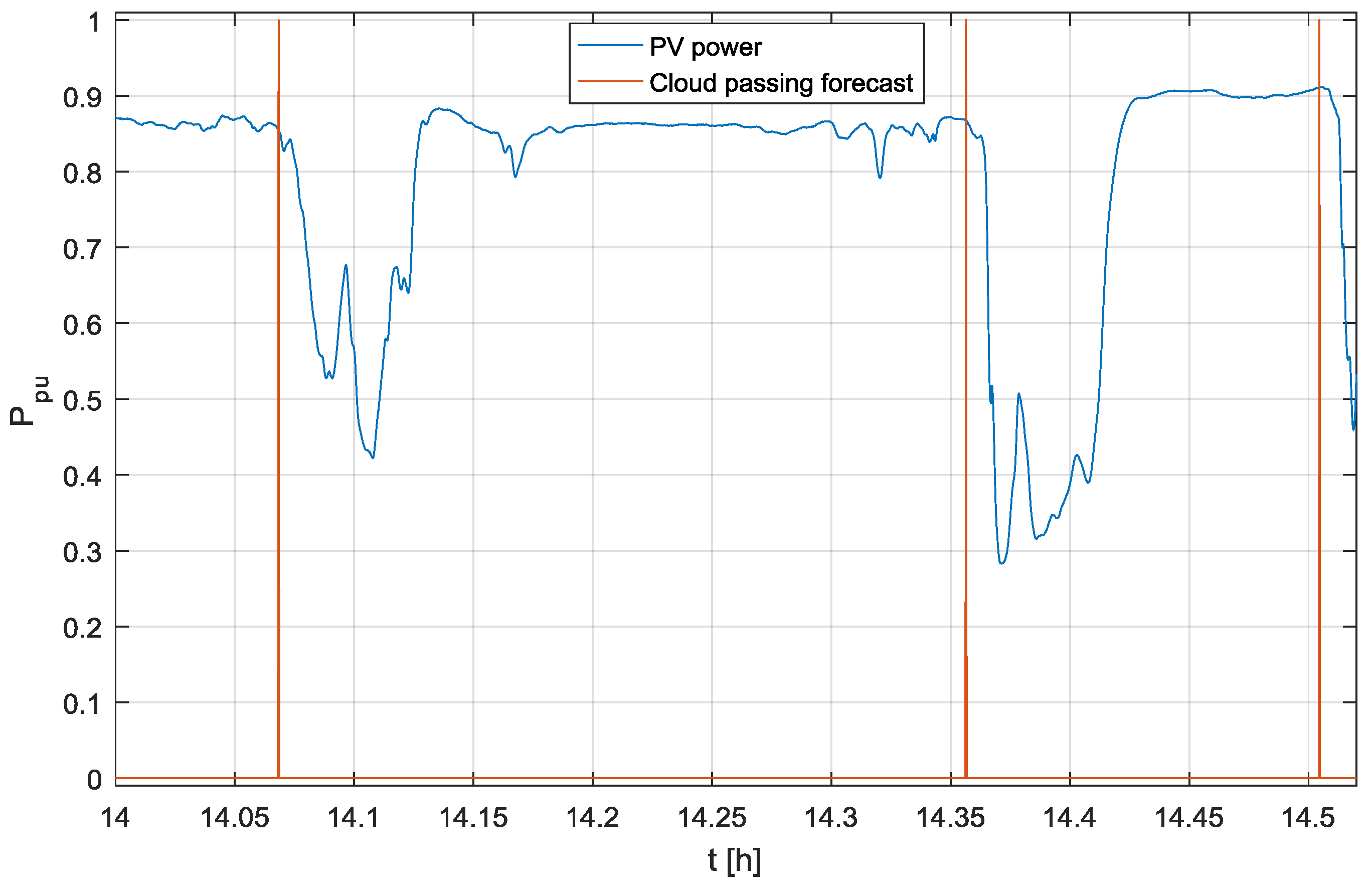
| Item | Price |
|---|---|
| Raspberry Pi 3 Model B (RPI 3 B) | 34 € |
| Waveshare RPi Camera (G) | 29 € |
| ND 4 Filter 52 mm | 3 € |
| CPL Filter 52 mm | 4 € |
| Total | 70 € |
© 2017 by the authors. Licensee MDPI, Basel, Switzerland. This article is an open access article distributed under the terms and conditions of the Creative Commons Attribution (CC BY) license (http://creativecommons.org/licenses/by/4.0/).
Share and Cite
Sukič, P.; Štumberger, G. Intra-Minute Cloud Passing Forecasting Based on a Low Cost IoT Sensor—A Solution for Smoothing the Output Power of PV Power Plants. Sensors 2017, 17, 1116. https://doi.org/10.3390/s17051116
Sukič P, Štumberger G. Intra-Minute Cloud Passing Forecasting Based on a Low Cost IoT Sensor—A Solution for Smoothing the Output Power of PV Power Plants. Sensors. 2017; 17(5):1116. https://doi.org/10.3390/s17051116
Chicago/Turabian StyleSukič, Primož, and Gorazd Štumberger. 2017. "Intra-Minute Cloud Passing Forecasting Based on a Low Cost IoT Sensor—A Solution for Smoothing the Output Power of PV Power Plants" Sensors 17, no. 5: 1116. https://doi.org/10.3390/s17051116





